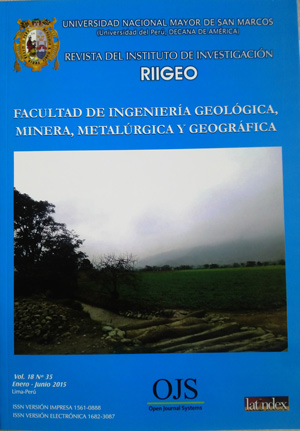Thiosulfate biooxidation as an indirect mechanism for mineral leaching using native acidophilic strains
DOI:
https://doi.org/10.15381/iigeo.v18i35.11842Keywords:
Thiosulfate biooxidation, native acidophilic strains, acid effluents, sulfide dissolution, potential ORPAbstract
The mechanisms of conversion to elemental sulfur, sulphites, sulfates and others; they are diverse, leading to the formation of sulfuric acid and therefore, to the acidification of the medium. Based on these characteristics, acidophilic bacteria are considered as sulfur chemolytotrophs, since they obtain their energy from the conversion of sulfur compounds and, in most cases, the final product is sulfate. The acid formed by these bacteria that oxidize sulfides is sulfuric acid. Similarly, bacteria isolated from acid drains, during their metabolic action, generate a decrease in pH. The Thiobacillus genus is relevant among the others for its ability to oxidize sulfur compounds, producing elemental sulfur extracellularly. The energy required to carry out its functions is derived from the oxidation of one or more reduced sulfur compounds including sulfide and thiosulfate. In the study of the oxidation of thiosulfate, the increase in the bacterial population was observed up to 8.6x108Cel / ml and oxide reduction potentials (ORP) of up to 615mV. At pH values between 1.8 and 2.2 and at thiosulfate concentrations of 2.2 gr / L . The greatest population increase of the bacteria was obtained in periods of 10 and 15 days of evolution. The monitoring of the potential made it possible to identify the state of operation of the sulfoxidant system. A direct relationship was found between the ORP and the bacterial population.
Downloads
Published
Issue
Section
License
Copyright (c) 2015 Vladimir Arias A, Daniel Lovera D., Jorge Diego C., Juan Gil R., Luis Ramírez O., Hans Cayo G.

This work is licensed under a Creative Commons Attribution-NonCommercial-ShareAlike 4.0 International License.
AUTHORS RETAIN THEIR RIGHTS:
a. Authors retain their trade mark rights and patent, and also on any process or procedure described in the article.
b. Authors retain their right to share, copy, distribute, perform and publicly communicate their article (eg, to place their article in an institutional repository or publish it in a book), with an acknowledgment of its initial publication in the Rev. Inst. investig. Fac. minas metal cienc. geogr.
c. Authors retain theirs right to make a subsequent publication of their work, to use the article or any part thereof (eg a compilation of his papers, lecture notes, thesis, or a book), always indicating the source of publication (the originator of the work, journal, volume, number and date).























